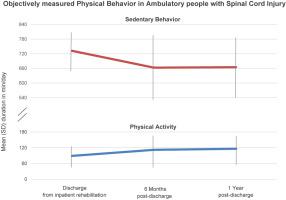当前位置:
X-MOL 学术
›
Arch. Phys. Med. Rehabilit.
›
论文详情
Our official English website, www.x-mol.net, welcomes your feedback! (Note: you will need to create a separate account there.)
Physical activity and sedentary behavior from discharge to one year after inpatient rehabilitation in ambulatory people with spinal cord injury; a longitudinal cohort study
Archives of Physical Medicine and Rehabilitation ( IF 4.3 ) Pub Date : 2020-12-01 , DOI: 10.1016/j.apmr.2020.06.027 Karin Postma 1 , Johannes B J Bussmann 2 , Tijn van Diemen 3 , Marcel W M Post 4 , Jos Dekkers 5 , Ilse J W van Nes 6 , Rutger Osterthun 1 , Rita J G van den Berg-Emons 2
Archives of Physical Medicine and Rehabilitation ( IF 4.3 ) Pub Date : 2020-12-01 , DOI: 10.1016/j.apmr.2020.06.027 Karin Postma 1 , Johannes B J Bussmann 2 , Tijn van Diemen 3 , Marcel W M Post 4 , Jos Dekkers 5 , Ilse J W van Nes 6 , Rutger Osterthun 1 , Rita J G van den Berg-Emons 2
Affiliation

|
OBJECTIVE
To evaluate changes in duration of physical activity (PA) and sedentary behavior (SB) from discharge to one year after inpatient rehabilitation in ambulatory people with spinal cord injury (SCI). DESIGN
Longitudinal cohort study with objective measurements of physical behavior at discharge, 6 months and 12 months post-discharge. SETTING
Three rehabilitation centers and the participant's home environment. PARTICIPANTS
Forty-seven participants with ambulatory function were consecutively recruited from the SELF-SCI cohort (age ≥18 years, recent SCI, expected inpatient stay ≥4 weeks). Mean (SD) age was 54.5 (12.9) years, all had incomplete lesions, 53% were men, 49% had tetraplegia, and 51% were community ambulators. INTERVENTIONS
Not applicable MAIN OUTCOME MEASURES: Duration (min) of PA (summed duration of walking, cycling, running, and wheeling) and SB (sitting/lying). RESULTS
Mean duration of PA increased by 21 min/day (95%CI: 7 - 35) and SB decreased by 64 min/day (95%CI: -94 - -35) from discharge to six months after inpatient rehabilitation. No changes were found in the second half-year. One year after discharge mean (SD) PA was 116 (59) min/day and mean (SD) SB was 665 (121) min/day. The increase in PA was the result of an almost doubling of time spent walking. Variability in physical behavior and its change was large. Older age and lower ambulation-level were associated with lower PA and lower ambulation-level with higher SB, while tetraplegia was associated with a reduced increase in PA. CONCLUSIONS
At group level, duration of PA and SB improved following inpatient rehabilitation in ambulatory people with SCI. However, there were large differences between individuals. Levels one year after discharge were still unfavorable, particularly with regard to SB.
中文翻译:

脊髓损伤门诊患者从出院到住院康复一年后的体力活动和久坐行为;纵向队列研究
目的 评估非卧床脊髓损伤 (SCI) 患者从出院到住院康复后一年的身体活动 (PA) 持续时间 (PA) 和久坐行为 (SB) 的变化。设计 纵向队列研究,客观测量出院时、出院后 6 个月和 12 个月的身体行为。设置三个康复中心和参与者的家庭环境。参与者 从 SELF-SCI 队列中连续招募了 47 名具有走动功能的参与者(年龄≥18 岁,近期 SCI,预计住院时间≥4 周)。平均 (SD) 年龄为 54.5 (12.9) 岁,均具有不完全病变,53% 为男性,49% 为四肢瘫痪,51% 为社区步行者。干预 不适用 主要结果测量: PA 的持续时间(分钟)(步行、骑自行车、跑步、和轮转)和 SB(坐着/躺着)。结果 从出院到住院康复后的 6 个月,PA 的平均持续时间增加了 21 分钟/天(95%CI:7 - 35),SB 减少了 64 分钟/天(95%CI:-94 - -35)。下半年未见变化。出院一年后平均 (SD) PA 为 116 (59) 分钟/天,平均 (SD) SB 为 665 (121) 分钟/天。PA 的增加是步行时间几乎翻倍的结果。身体行为的变异性及其变化很大。年龄较大和较低的走动水平与较低的 PA 相关,较低的走动水平与较高的 SB 相关,而四肢瘫痪与 PA 增加的减少相关。结论 在组水平上,门诊康复后 SCI 患者的 PA 和 SB 持续时间有所改善。然而,个体之间存在很大差异。
更新日期:2020-12-01
中文翻译:

脊髓损伤门诊患者从出院到住院康复一年后的体力活动和久坐行为;纵向队列研究
目的 评估非卧床脊髓损伤 (SCI) 患者从出院到住院康复后一年的身体活动 (PA) 持续时间 (PA) 和久坐行为 (SB) 的变化。设计 纵向队列研究,客观测量出院时、出院后 6 个月和 12 个月的身体行为。设置三个康复中心和参与者的家庭环境。参与者 从 SELF-SCI 队列中连续招募了 47 名具有走动功能的参与者(年龄≥18 岁,近期 SCI,预计住院时间≥4 周)。平均 (SD) 年龄为 54.5 (12.9) 岁,均具有不完全病变,53% 为男性,49% 为四肢瘫痪,51% 为社区步行者。干预 不适用 主要结果测量: PA 的持续时间(分钟)(步行、骑自行车、跑步、和轮转)和 SB(坐着/躺着)。结果 从出院到住院康复后的 6 个月,PA 的平均持续时间增加了 21 分钟/天(95%CI:7 - 35),SB 减少了 64 分钟/天(95%CI:-94 - -35)。下半年未见变化。出院一年后平均 (SD) PA 为 116 (59) 分钟/天,平均 (SD) SB 为 665 (121) 分钟/天。PA 的增加是步行时间几乎翻倍的结果。身体行为的变异性及其变化很大。年龄较大和较低的走动水平与较低的 PA 相关,较低的走动水平与较高的 SB 相关,而四肢瘫痪与 PA 增加的减少相关。结论 在组水平上,门诊康复后 SCI 患者的 PA 和 SB 持续时间有所改善。然而,个体之间存在很大差异。



























 京公网安备 11010802027423号
京公网安备 11010802027423号